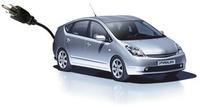Southern California Tests Valence Powered EnergyCS Plug-in Vehicles
AUSTIN, Texas--Valence Technology, Inc. , a provider of advanced lithium-ion battery systems, has collaborated with plug-in hybrid conversion company EnergyCS to deliver green, fuel-efficient electric vehicles to the South Coast Air Quality Management District (AQMD). AQMD, Southern California’s air pollution agency, is testing the Valence U-Charge® powered plug-ins to further awareness of the environmental and performance benefits of plug-in technology.
AQMD’s pre-commercial plug-in hybrid electric vehicle, or PHEV, is based on a technology demonstrator kit designed for 2004 – 2007 model year Toyota Prius. The vehicle is outfitted with Valence lithium-ion rechargeable batteries and custom monitoring and control electronics designed by EnergyCS, to increase zero emissions miles and double the Prius’ fuel economy. Valence’s Saphion® lithium-ion battery pack, with approximately 9 kWh of energy storage, will replace the Prius’ original nickel metal hydride battery, thereby extending the usable energy storage by over 18 times. AQMD actually has two of these vehicles.
AQMD has invested eight years into the research and evaluation of plug-in technology and is working with the state to support the Plug-in California Initiative sponsored by AQMD Board Member and Riverside Mayor Ron Loveridge. This program is looking to provide buyer and supplier incentives to further the adoption of plug-in technology.
“We are pleased to be one of the first organizations to test the EnergyCS plug-in technology using Valence’s phosphate-based lithium-ion batteries,” said Miguel Pulido, Mayor of Santa Ana and an AQMD Board Member who is test-driving the plug-in hybrid vehicle. “We look forward to releasing the demonstration results over the next several months and anticipate it will show reduced smog-forming and greenhouse gas emissions from the vehicle.”
Specific tests include evaluation of the battery performance and life, maintenance and expansion of the EV mode, fuel economy compared to a conventional HEV and driver experience. Once fully tested, the demonstration phase will apply the PHEV technology to other test vehicles to ensure the emissions are maintained at super-ultra-low emission vehicle (SULEV) levels.



